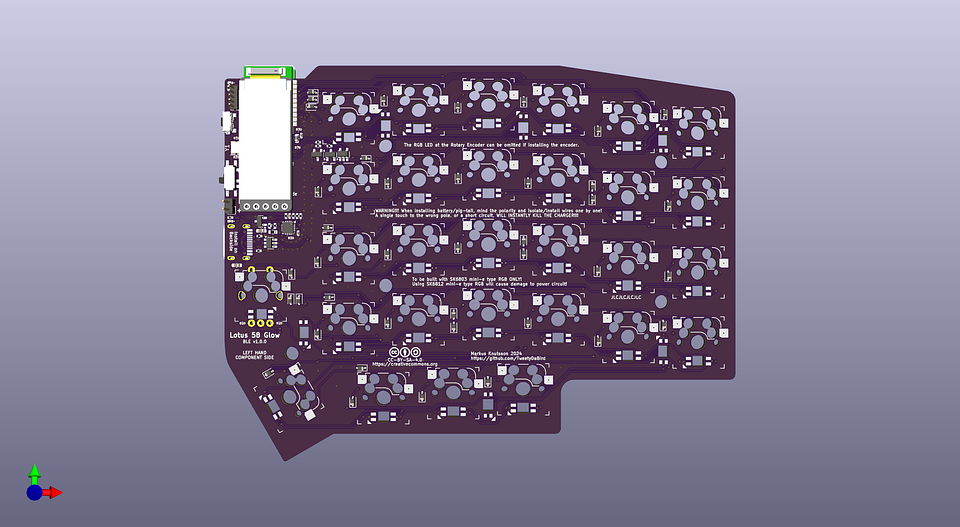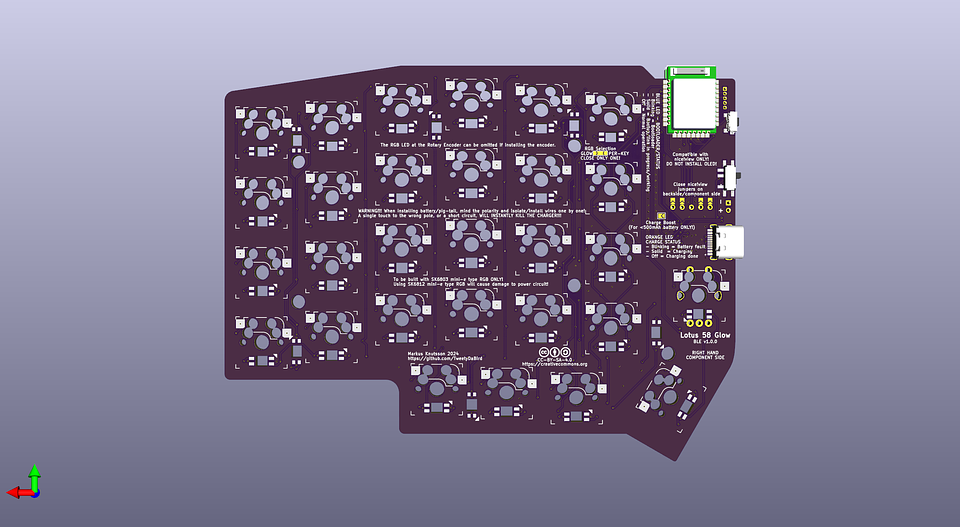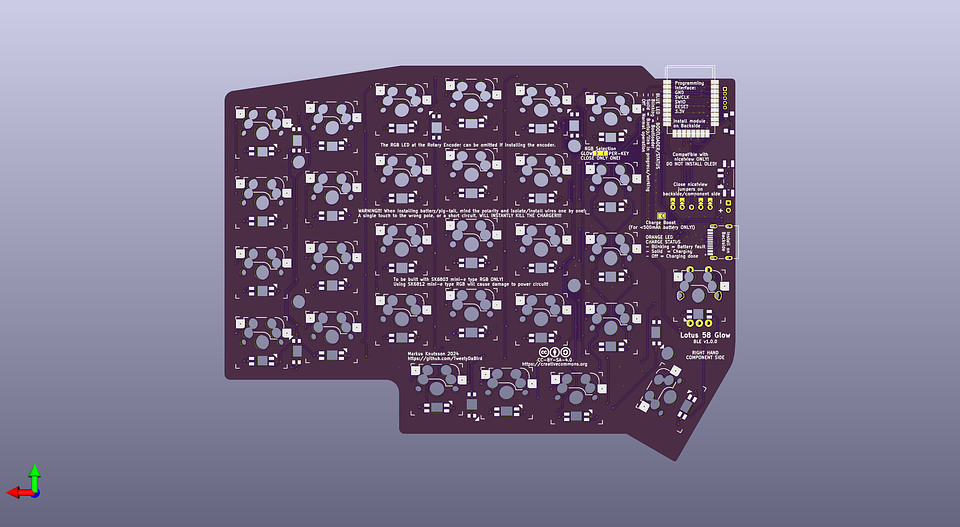The Lotus 58 Keyboard
The Lotus 58 is a family of ergonomic split keyboards that can be customized and programmed to suit your individual needs.
The Lotus 58 Keyboard is meant to be DIY & beginner friendly, allowing almost anyone to succesfully build it from a kit to a finished keyboard, regardless of your previous level of experience soldering and tinkering, and with access to mostly basic level tools.
Some previous experience soldering is a great help but not in any way neccesary. Most components are selected to be large enough and robust enough to survive being handled by an inexperienced builder, and still produce a nice, clean keyboard, that functions well.
The 58 key layout is meant to be roughly equivalent to a 60% keyboard with a number row, but with no dedicated function keys, and with a gentle stagger, it should suit most hand sizes witout having to reach for the keys. Basically, it's meant to be a good middle ground, and to suit most users.
Cases and plates are meant to be largely interchangeable between different variations of Lotus 58, with obvious caveats for what layout you select, requiring the top plate to match (OLED/Encoder/Blank).
Lotus 58 - BLE
Lotus 58 - BLE is the continuation of the wired Lotus 58 designs, but now designed specifically to be wireless using Bluetooth™ BLE.
Sold as a kit with two PCB's and components, you will need this kit, a case and accessories to make a complete keyboard.
Why a dedicated design?
With a PCB that is designed from the ground up for wireless, the antenna can be placed in a much more optimal position, and power delivery can be optimized for every part. All the while fitting into the outline of the old design without too much compromise, meaning it's mostly compatible with existing cases and plates, depending on your choice in accessories.(Although for wireless/BLE please avoid metal cases & plates for obvious reasons!)
A low powered display, done the right way. With the low power requirements of the nice!view, it's powered from the nRF52840 chipsets internal regulator with no inefficient regulator/power conversion needed. This means that with the nice!view display on your Lotus 58 - BLE is always powered¹, and also that it is as efficient as it possibly can be. And since the nice!view is only using power when it's image is actively updated, it has almost no impact on your overall battery consumption.
And if you insist on adding RGB to a wireless keyboard, despite the penalties to battery life, this is now integrated in the most efficent way possible, by powering the RGB directly off of the USB/battery voltage, with no regulator in between. Just like with the nice!nano you can turn off the 'external power' to disable the RGB by a key-bind in ZMK, although now it turns off only the power to your RGB, and the nice!view displays stays powered, showing you battery and connection status at all times.
A power switch that allows you to charge the battery when powered off. The power switch isn't actually a battery disconnect in the true sense, as it instead keeps the controller in a 'powered off' mode, regardless of whether the USB power is plugged in or not, and it still allows the battery to charge if the keyboard is plugged in to a computer or charger.
Lotus 58 - BLE can be built as a DIY-kit from components or bought mostly finished, and is delivered as a semi populated PCB with all the smaller SMD components already soldered from factory, to either be finished to your own preference by soldering the larger and relatively speaking 'simpler' parts yourself like the controller module², hotswap sockets, the display/encoder and RGB. Or, you can select to have it pre-soldered as a fairly barebones, but ready to use keyboard (No RGB/Encoder/nice!view installed), ready to flash with your preffered keymap.
Or if you prefer to avoid soldering completely and want some of the optional extras installed out of the box, you can choose to have it fully built and ready to program.
Main Features:
- Features 56-58 keys, with a 4x6 main matrix and 4+1 thumb-keys per hand.
- Supports up to one Rotary encoder and one nice!view display per hand.
- Designed with a Sandwich-style plate/case as part of the design and with 3D printed cases as added options.
- Fully ZMK compatible, with every aspect of it being programmable.
- Kaihl Hot-swap sockets for Cherry MX compatible switches.³
- Nordic nRF52840 chipset, with 1MB Flash & 256KB RAM.
- USB-C connector to host computer, (USB 2.0 device).
- Low-power sleep and dormant modes.
- Drag-and-drop programming using mass storage over USB.
- Ti BQ24075R battery charger, 4.2V Lithium @ 100/500mA charge rate.
- Power Path, charges the battery as optimal even when the keyboard is used.
- Supports a 120-500 or 500-1750 mAh size battery per hand - Please use ZMK Power-profiler to calculate your expected battery time.⁴
- Can be built with a pigtail battery connector for easy battery installation. (Standard JST connector).
Build Features:
- Main SMD components are delivered fully soldered, with larger and easier to solder components optionally as DIY, or fully soldered as per your preference. (Some prior soldering experience is prefferable, but not neccesary)
- The PCB design is reversible, making the PCB for both hands identical for a much lower cost.
Optional Features:
These options require additional parts
Read more about RGB support in ZMK
Physical dimensions:
Dimensions per hand (LxBxH): 145x115 mm Case height 11-13mm, Height with keycaps/encoder ~35mm
Basic Components
Parts included in the DIY-kit:
| Part |
Quantity |
| Main PCB |
2 pcs |
| nRF52840 module (E73-2G4M08S1C) |
2 pcs |
| USB type C port |
2 pcs |
| Power Switch |
2 pcs |
| Reset Switch |
2 pcs |
| Hot-Swap Sockets (Kailh Cherry MX) |
58 pcs |
What do you need to buy?
You can buy most parts for a full functioning keyboard in this listing or as additional components in this store. You will however need to add switches, key-caps and colored/sleeved charging cables of your choice from other sources, as it would be impossible for me to stock a reasonable selection of what the market can offer.
I however DO NOT, sell LiPO batteries. This is since shipping them to various parts of the globe as a small, one man operation with limited volume, is entirely un-economical both for me as the seller, and for you as the customer, as it requires a fair bit of hassle with various customs regulations etc. taking time that I then have to add onto the price. And I simply cannot keep the volume up enough to make the price competetive in the first place, so you are far better off sourcing this on your own.
For a bare minimum functional keyboard you will need:
- This PCB Kit - 2 PCBs with the components to build them as a compete keyboard.
- Case Kit (x2) with hardware or a 3D printed case or similar
Required Accessories
- Key Switches, Cherry MX compatible (58 pcs)
- Key Caps, Cherry MX compatible (Set)
- LiPo 3.7V nominal voltage (4.2V fully charged) battery 120-750mAh (2 pcs)
- USB cable to your computer for charging (USB type C to USB type C/A)
The Sandwich Case
Lotus 58 is designed as a complete keyboard with a sandwich style case of the same FR4 fibreglass material as the PCB.
The FR4 fibreglass plates used are quite stiff and give a good intermediate feel for keyboards, making it the ideal low cost material for a case. The 'case plates' are available in black or white, with multiple options based on your choice of layout.
Please Note! You do infact need a case of some kind, as being hot-swap compatible the front plate helps hold the switches in place, and without the plate, they will very easily come undone. You can however 3D print your own case, or have plates made in whatever material you desire. All the information required for this can be found on the linked GitHub page.
Specific caveat for Lotus 58 - unWired & BLE: These products should not be used with a metal case (both ferrous and non-ferrous metal, ie Aluminium), either CNC machined or as plates, as it reduces wireless performance and increases battery consumption noticeably.
Build Level
DIY Kit
This one is fairly obvious. You get a pair of PCB with the smaller SMD components already soldered and tested, and you solder all the other larger parts like the USB port and hot swap sockets yourself, and you need to flash the needed boot loader for the modules. Note that this requires you to have a hardware device³ to flash the boot loader for the modules. Soldering the modules are slightly more advanced than I'd recommend for a complete novice, but if you have just some experience soldering from before, it is not difficult, just slightly time consuming.
Partially Built
If you do want to build most of the keyboard yourself, but are either a novice at soldering or unsure and want a little help. Or, in this case, if you simply do not want to purchase the additional hardware device to flash the boot loader. With this option, the wireless modules and the USB port are soldered and the modules flashed with the boot loader needed to flash over USB. You still need to solder most larger parts of the keyboard yourself, but the difficult parts are already done.
Fully Built
This option allows you to have a fully built, ready-to-use keyboard, where you simply need to add the battery, and configure the firmware (ZMK) as well as physically assemble the case/keys/caps you have chosen to start using it. This option includes soldering any extra components like encoders if included with the purchase. Note that the encoders are a separate product, and this price do NOT include them.
Feature Comparasion
| Feature |
Lotus 58 - TRRS |
Lotus 58 - USB-C |
Lotus 58 - BLE |
Lotus 58 - unWired |
| Wired Build |
✅ |
✅ |
🛑 |
🛑 |
| Wireless Build |
⚠️¹ |
🛑 |
✅ |
✅ |
| Battery Switch |
✅ |
🛑 |
✅ |
🛑 |
| OLED |
✅ |
✅ |
🛑 |
🛑 |
| nice!view |
🛑 |
🛑 |
✅ |
🛑 |
| Encoder |
✅ |
✅ |
✅ |
🛑 |
| Full RGB |
✅ |
✅ |
⚠️² |
🛑 |
| Dongle |
🛑 |
🛑 |
⚠️³ |
✅ |
| Cherry MX (3 & 5 pin) |
✅ |
✅ |
✅ |
✅ |
| Choc v1 / Choc v2 |
🛑 |
🛑 |
🛑 |
🛑 |
⚠️¹ The Lotus 58 - TRRS can be built as wireless with a nice!nano controller, and has some amenities for it. It is however in no way optimized for this with the antenna placement etc.
⚠️² For battery life and efficiency it's NOT recommended to use both Per-Key and Glow RGB at the same time on Lotus 58 - BLE, but it is certainly possible.
⚠️³ As all ZMK compatible split keyboard Lotus 58 - BLE can be configured with a nRF device as a dongle, but this is outside the scope of the delivery. (Please read more in ZMK's official documents).
¹ While the nice!view technically remains always powered, because of the Sharp MIP technology, it only uses power as it's image is actively refreshed, and then only typically ~10μA, making it incredibly power efficient, but lacking 'backlight' and relying on reflective light.
² Segger J-Link - For the full DIY option, flashing the boot loader to the modules requires a Segger J-link or equivalent hardware flasher.
³ Please note that Lotus supports only Cherry MX type switches (3 & 5 pin), NOT Kaihl Choc, as they require a different PCB design.
⁴ Set as 'Custom board', check 'Split Keyboard', 'Switching PSU', and other settings as default, and add your battery size, nice!view and RGB as desired.




